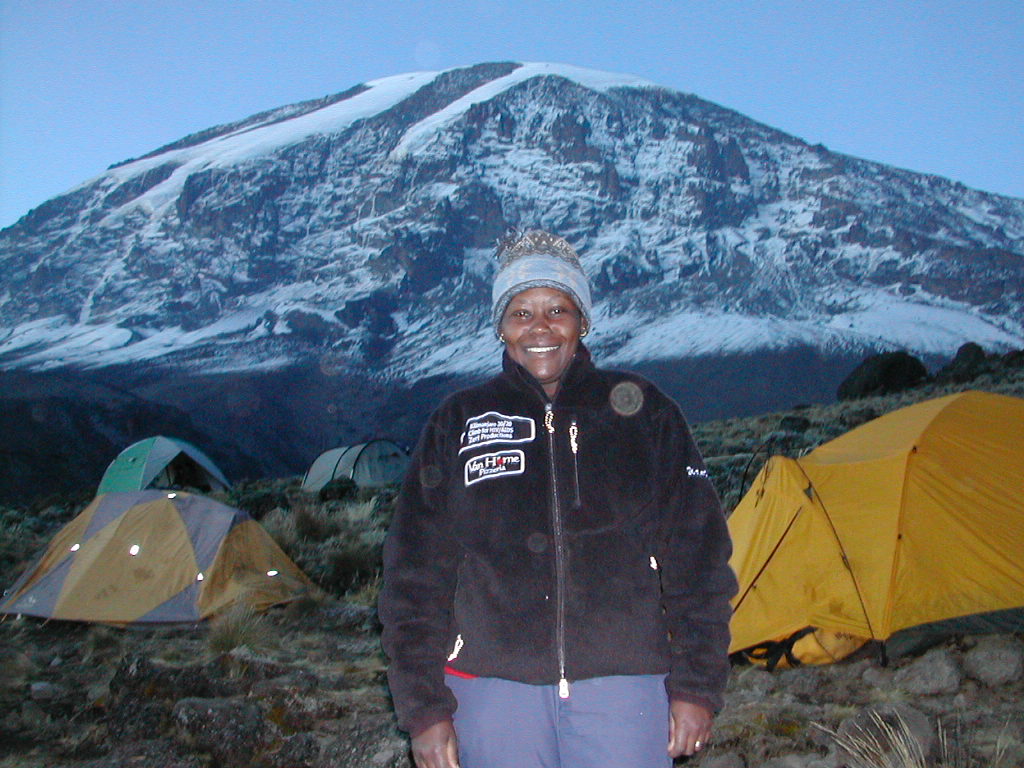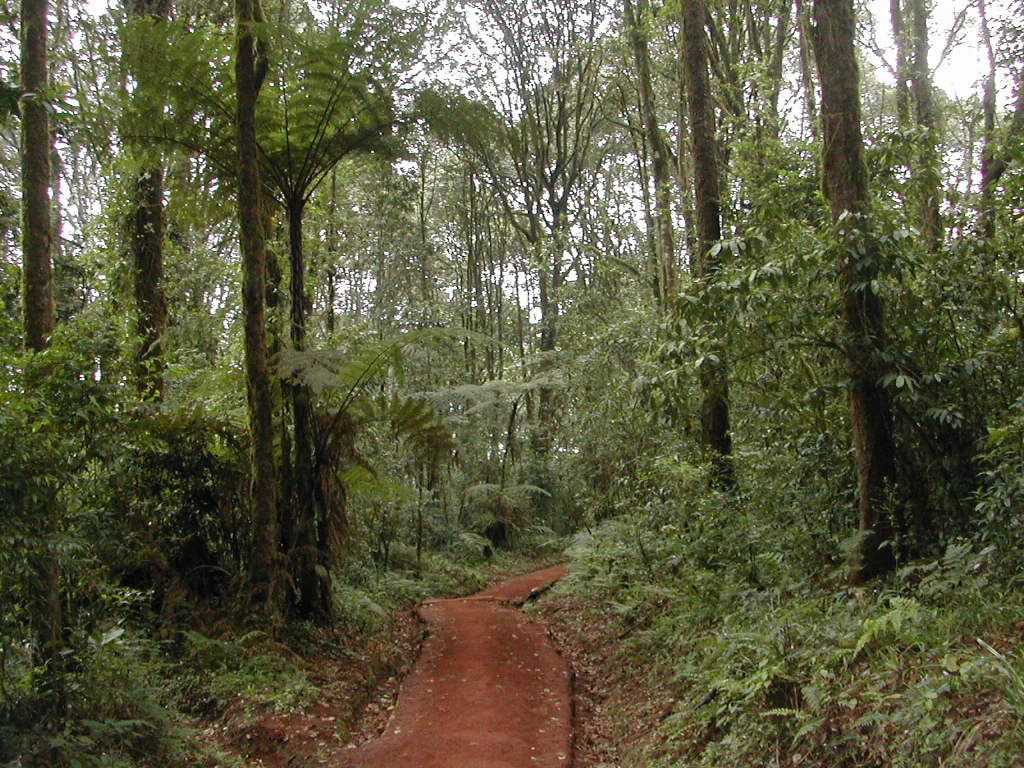Kilimanjaro

The Challenge
A few years ago at the breakfast table, my husband, Tony asked me what my long-term goal for the next year was going to be. I told him that I would climb Mount Kilimanjaro. He paused from munching on his toast, stopped sipping his coffee, put on his business coach hat and commented: “That’s not a smart goal darling”. After he had wiped the egg off his face he explained that SMART is an acronym used in goal setting;
- Specific
- Measurable
- Attainable or Achievable
- Relevant
- Time bounded
My goal, he explained, satisfied the SMAR but not the T. I immediately amended the goal to read, “I am going to climb Mount Kilimanjaro before the end of 2004” But, in my heart, I knew that I was not going to climb Kilimanjaro just for the sake of climbing a mountain.
I needed a purpose. After asking around for information on Mount Kilimanjaro, most of my friends assured me that it was too big a goal and that I was out of my mind. By January 2004, I was beginning to despair, when a friend emailed me to tell me that she had met someone who was looking for people to climb Mt. Kilimanjaro to help raise awareness of the AIDS/HIV epidemic in Africa and to also raise funds for AIDS orphans. 
After contacting Dr. Wilhelmina Fredericks, Director and founder of ZERF productions – the group behind this exciting project, I was hooked and jumped on board immediately. We got busy and started putting a group together.
YMCA Westmount generously agreed to give memberships to the group and provide trainers. In February 2004, we had a team made up of 13 members, and our adventure begun.
In September of the same year, after 8 months of training and fundraising, we were ready to go challenge the mountain – Kilimanjaro, an extinct volcano, the tallest mountain in Africa, 19340 ft and the tallest free-standing mountain in the world. In the local Wachagga dialect, Kilimanjaro means the “journey with no end”. We were soon to learn why Kili was so named.
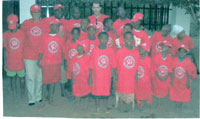
The whole group got to Moshi on Wednesday September 22nd. We had brought T-shirts and hats that one of our sponsors had donated, and as soon as we had located our rooms in the hotel, we went out to the village to distribute them. In about an hour, 60% of the population in the village was wearing “Proudly Canadian” hats and T-shirts.

The afternoon was spent in a local children’s home – Amani Children’s home that caters for about 60 children – all orphans of the AIDS/HIV epidemic.
The children took us through a tour of their home.

They try to be as self-sufficient as possible, growing what little food they can, washing their own clothes. It was sad and yet special to see a 6 year old washing her clothes!
The following day was spent at the hotel with the guides going through personal gear.

Anything that was not going to be useful on the mountain was to be left at the hotel. We also went through the safety gear, first aid equipment and were briefed about medication and medical emergencies on the mountain.
September 24th 2004
The Climb began
Machame Gate to Machame Hut:

We set out from the Machame route gates at around noon. This day was going to take us through the rain forest and we were lucky to get beautiful weather. We had seen videos of groups that went through the first day in rain and mud…but our day was dry and sunny. What a treat!

As we climbed, the guides and porters kept reminding us of the Kilimanjaro mantra “Pole, Pole” Swahili for, “Slowly, Slowly”. This was going to be our mantra for the rest of the climb. Go too fast, and altitude sickness will catch up with you very quickly. We got to the camp late in the afternoon to a nice treat of tea and popcorn….yeah popcorn on Kili!
The tents were all set up and all we had to do was to chose one – one tent for two – collect our gear from the porters and get ready for the night. We had an early night, but no one slept well through it. We had gained altitude of about 6000 ft and most of the climbers were feeling the effect of the altitude.
September 25th 2004
Machame Camp to Shira Camp (3 890m)

We woke up to a beautiful day and as we ate our breakfast, the sun was shining softly on our faces but this did not last all day. I should mention here that breakfast was my most enjoyable part of the day. Oh, we were fed like kings on the mountain. The cook was Alex, a lovely man from Tanzania. Porridge….tastier then any other porridge I have ever tasted, French toast, plain toast with peanut butter, honey or fruit jelly, fruit (papaya, oranges, pineapple, bananas), eggs (scrambled, fried or Spanish omelet) and for the meat eaters bacon, tea or milo (malt drink made with hot milk or hot water – tastes like hot chocolate.
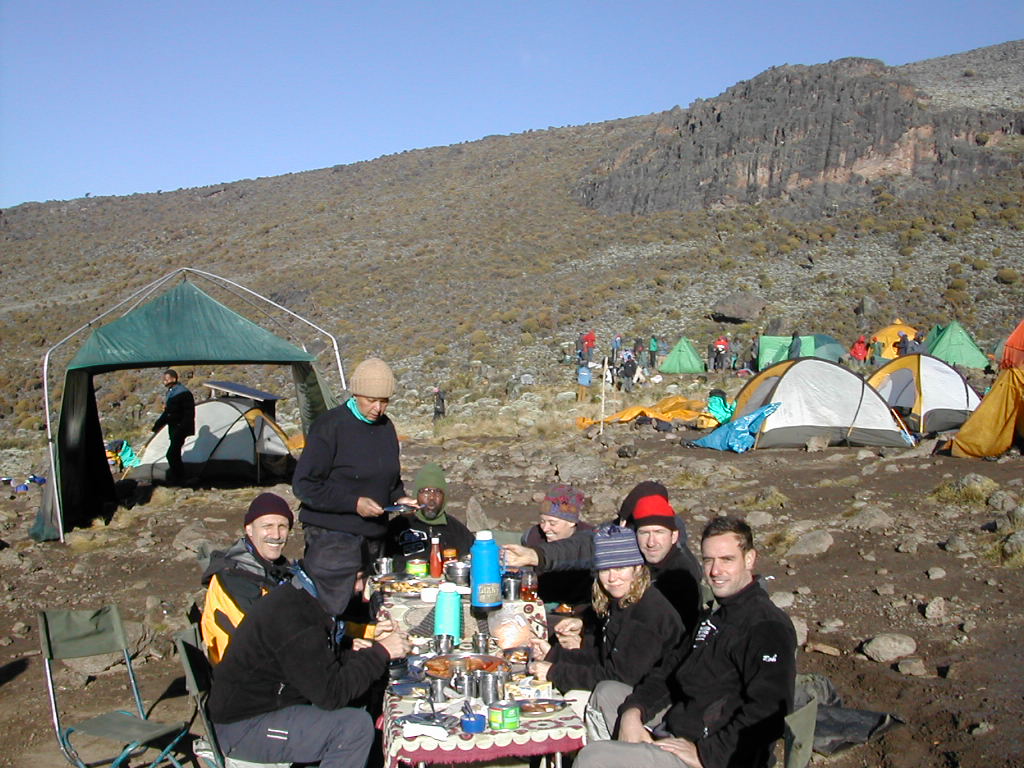
As soon as we started climbing, the weather change to rain and hail. Being the first serious days of the climb with a weather shift, some of the climbers were not prepared, and by the time we stopped for lunch, we had to dig deep into our packs for dry clothes to lend to some very cold members of the team! After a nice lunch and some hot tea, and a little convincing, everyone was ready to start again and we continued to Shira Plateau. Shira plateau separates Kibo (the highest peak) from Shira Cathedral and Shira Needle peaks. As we were crossing the plateau, the weather became bearable.
September 26th 2004
Shira Camp to Lava tower (4630m) then on to Barranco camp (3950m)

You will have noticed that we climbed to 4630 metres – Lava tower and then descended to 3950m at the Barranco camp. This is the technique used for acclimatization on Kilimanjaro. Climb high and sleep low, is the recommendation.
Going down the Barranco valley was exciting, partly because it is downhill, but the views are magnificent. The only plants that had survive this altitude are giant lobelia and senecio, and they created a beautiful forest on the valley.
September 27th 2004
Barranco Camp by the Barranco wall (4260m) and down to Karanga Valley camp (4000m).
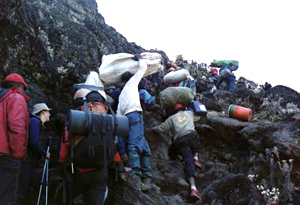 I think this was the most challenging, yet enjoyable part of the ascent. We started our morning in beautiful weather – nice warm sun shining on us. Things then started to change as we got to the Barranco wall. It seems like the whole town of Moshi has an appointment on this wall. All climbers on the Machame route seem to have arrived at this wall at the same time. Porters with 40+pound packs on their shoulders, climbers, guides, everyone! The trail is narrow and the wall is a 6oo ft+ cliff, which is a scramble really. I remember climbing most of it using both hands and a few pushes from the back by friends…No wonder the wall is named “Breakfast Wall”! You work out all your breakfast here. After the wall, the trail evens out for a few metres, and then it is a scramble to the 4260m mark. We had a well-deserved break at the point then headed down to Karanga Valley camp.
I think this was the most challenging, yet enjoyable part of the ascent. We started our morning in beautiful weather – nice warm sun shining on us. Things then started to change as we got to the Barranco wall. It seems like the whole town of Moshi has an appointment on this wall. All climbers on the Machame route seem to have arrived at this wall at the same time. Porters with 40+pound packs on their shoulders, climbers, guides, everyone! The trail is narrow and the wall is a 6oo ft+ cliff, which is a scramble really. I remember climbing most of it using both hands and a few pushes from the back by friends…No wonder the wall is named “Breakfast Wall”! You work out all your breakfast here. After the wall, the trail evens out for a few metres, and then it is a scramble to the 4260m mark. We had a well-deserved break at the point then headed down to Karanga Valley camp.
This was a short day. We needed the rest to prepare for the next days hike to the summit.
September 28th 2004
Karanga valley to Barafu Camp (4 550m).
 Barafu is Swahili for ice.
Barafu is Swahili for ice.
The land is bear of vegetation at this level. All is just lava rock, shale, and scree. We woke up to a cold morning with the ground covered in light snow. We arrived at the Barafu camp at around 1:30 pm. The guides timed it in such a way so that we would have enough time to rest before setting off for the summit. As we arrived, other groups were coming down from the summit, so we had to wait for them to leave before we set camp. I kept wondering how the tents were going to be pitched up on the rocks…..how were we going to sleep with our bodies pressed on those huge rocks. 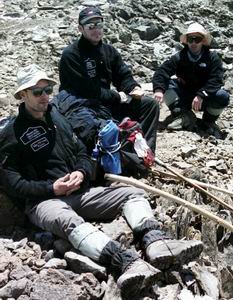 The porters are experienced and they found the right spot for each tent. As soon as the tents were up, lunch was served. Then it was nap time (mandatory nap) before the summit attempt. Dinner was a carbohydrate overload – beans, pasta, French toast (guess we had to finish off the last of the bread) and fried potatoes! After dinner we were asked to sleep again for a few hours – 2 hours – before the wake up call at 11:00 pm.
The porters are experienced and they found the right spot for each tent. As soon as the tents were up, lunch was served. Then it was nap time (mandatory nap) before the summit attempt. Dinner was a carbohydrate overload – beans, pasta, French toast (guess we had to finish off the last of the bread) and fried potatoes! After dinner we were asked to sleep again for a few hours – 2 hours – before the wake up call at 11:00 pm.
Summit day: September 29, 2004
Barafu camp to Stella point (5,695m) and Uhuru peak (5,895m)
The summit trek is set in such a way that climbers begin climbing at midnight. This allows them to set off under the full moon, when the ground is still not too wet from the melting ice, and they can reach the summit in good time for sunrise.
It was tough getting dressed at midnight, with very little light, trying to get on the five layers of warm clothing. We all felt and looked like the Michelin man in all those layers of clothes. The one thing you did not want to forget before getting dressed in all those layers, was the trip to the outhouse – after all the tea and water we had consumed!
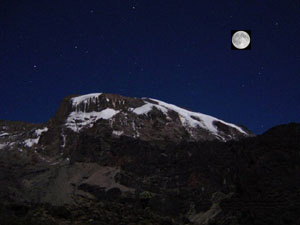
We set off in great excitement under the light of the moon – a full moon ascent. The next few hours were really going to be a test. As test on the human spirit, human strength – it would take our “ALL” to get to the summit. As our guides had informed us, we had to be prepared to DIG DEEP and tap into our strength, motivation and energy for the rest of the hike. We were in our full “Pole, Pole” mode. No talking! Just walk, breathe, stop, drink, rest, and off again.
Most of the climb is just going over huge boulders, and rock walls. All I could think of was -just put one foot in front of the other! Breathing at this height was really becoming a challenge. Most of the climbers’ water froze with the extreme cold. It become very difficult to even undertake simple tasks like opening water bottles and some climbers had to be helped. Nausea begun to set in for most. It was cold out. It was 10F/-10C at Barufu, and it was even colder now. The extra mittens had to come out now.
By this time I was leading the pack, right behind Simon and we keep plodding along, and the sky starts to lighten. Even at this altitude, Simon can manage to sing – life is not fair….I could hardly breath! Two days later when I asked him why he was singing on the summit, he told me that he did that to encourage us to push on.
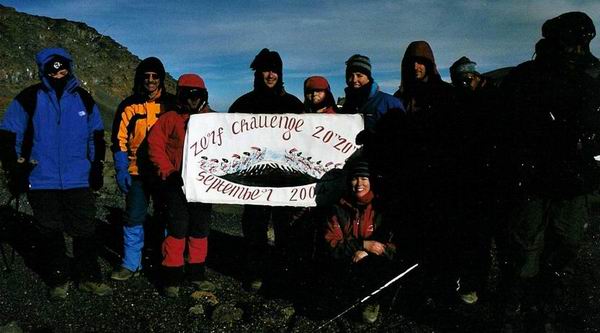
At about 6:30am, the sun was shining behind Mawenzi, the 2nd highest volcanic cone on Kili. We are happy to see the sun and this is a real encouragement to keep pushing. At about 6:00am we all reached the Stella point of the crater rim. We are all so exhausted, cold, thirsty, and some even hungry.
There were other climbers coming down from the summit, and there is a bit of confusion as we see under-oxygenated climbers being rushed down, others collapsing from sheer fatigue or hypothermia! We take a group photo, rest for a while, trying to enjoy the view of the glaciers from the top. Finally, we all have to make an individual decision – press on or turn back? The group was divided. 6 opted to turn and head back down, and 5 of us decided to press on to the summit – Uhuru peak.
The Summit of Kilimanjaro
For those of us who pressed on to Uhuru peak (5895 meters), it was another hour of “Pole, Pole” (slowly, slowly) at an even more “Pole, Pole” pace. Now I understand why Kilimanjaro, in the Chagga language, is known as the ‘journey that never ends’. I did not think I would make it to the top, but with a little encouragement from Simon, our chief guide, I pushed on. The air was thinner than at Gillman’s point and although the climb was not particularly steep, it was extremely tiring. I think my brain was numb at this point, all I could do was put one foot in front of the other – no cooperation from my brain as it kept on saying – you are crazy! During most of the climb, our oxygen levels were averaging at about 90%. At the top, everyone was in the 70% range. Even the guides! I had never before functioned with such low levels of oxygen!
Kilimanjaro boasts five major ecological zones. The summit zone (5,000 to 5,895 meters), is just bare volcanic rock. No sign of life – except for us!
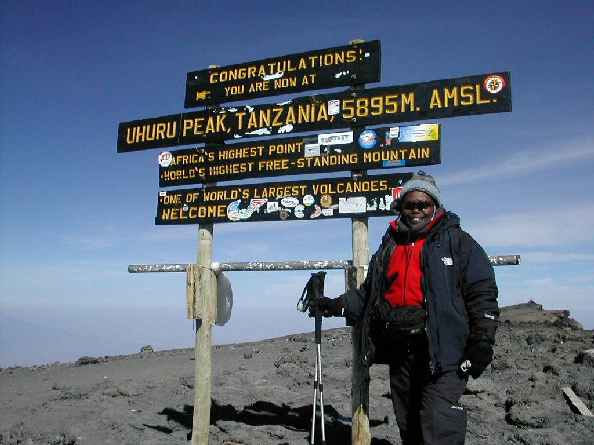
Once we got to the top, it was the great WOW! We had made it! It was unreal. No two people have the same feeling on reaching Uhuru peak, it is a mixture of relief, disbelief that one had made it that far, and wonder at the beauty of that bear piece of land standing out on top of the world! It was literally breathe taking! Machame route, deserves its name “whiskey route” – the view from the top is intoxicating. But, with the oxygen levels being so low, there was no idling around. We quickly posed for the necessary photos with banners, flags, hugged, shed some tears of joy, and maybe of exhaustion and headed back down as fast as we could. We all wanted to get some richer air, further below.
Descent from Uhuru Peak (5,898m)
followed by descent to Millennium camp (3,690m)
The downhill part was not any easier. Although the oxygen levels get better as one descent, it is very tough on the knees. Gravity is hard on the body. The steep scree slope was frozen when we climbed at midnight, but now, the sun was hot and the rocks loose. The best we could do was cooperate with gravity and just slide down. My knees were doing better than I expected. Thank you knees! But my head feels felt it was going to explode.
I now had a dry cough from all the dust from the scree. Each time I bend down to tire my boots, pick up something or when I try laughing….I cough…..ahh….chest, what is it now! When I made the comment that I should not laugh because I am coughing each time I laugh, Eric suggested that I should try coughing…! Very funny. It is almost 10:00 am and we have been walking since midnight and at the end of the day, we had walked 18 Km! We ascended 3,600 feet and descended 7,200 feet in a period of 12-18 hours. I had not managed to eat anything….maybe because I had no appetite, or just the fatigue, but I knew that at some point I would have to force myself to eat to get the energy for the rest of the descent. 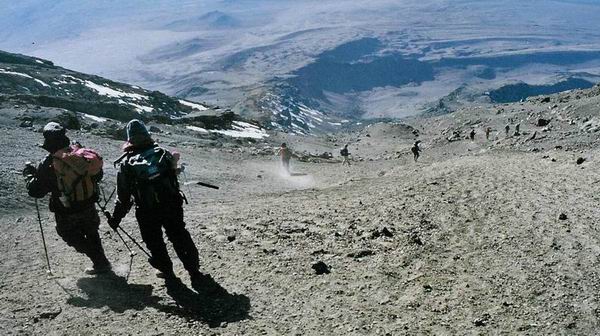 Eliakim, the lovely photographer/guide was showing me how to ski on the scree, that made it easier on the knees and helped us move faster. Yeah, I live in a country where I can ski, never ski, and now I am in Africa learning the skiing technique! Eric and Patrick (chui) were way ahead of us. Jacqui raced down with Simon. At this point I was thinking – would I climb Kilimanjaro again – not even if you paid me!!
Eliakim, the lovely photographer/guide was showing me how to ski on the scree, that made it easier on the knees and helped us move faster. Yeah, I live in a country where I can ski, never ski, and now I am in Africa learning the skiing technique! Eric and Patrick (chui) were way ahead of us. Jacqui raced down with Simon. At this point I was thinking – would I climb Kilimanjaro again – not even if you paid me!!
11:30 am Eric and Patrick stopped – altitude sickness was kicking in from descending so fast. We caught up with them and I proposed that we stop to eat. All I could manage to eat is a tiny piece chocolate that had been thoughtfully packed in each of our lunch packs…..thank God for chocolate. You can tell, I am not thinking of calories at this point!
Looking back up, we could see how far we had climbed and looking down, we could see the magnificent views of the valleys down below. Two hours after beginning our descent, we could see Barafu. At this point, we were running to get to the camp as fast as we could.
At Barafu, we shed some of the layers of clothing that we wore for the summit. Then, it was lunch, packing and heading out for Millennium cap. It was going to be another 2 to 3 hours before we could put our heads down to rest for the night. Ah, the human spirit! I realized how strong the human spirit was on this day.
September 30, 2004
Millennium Camp to Mweka village (1,500m)
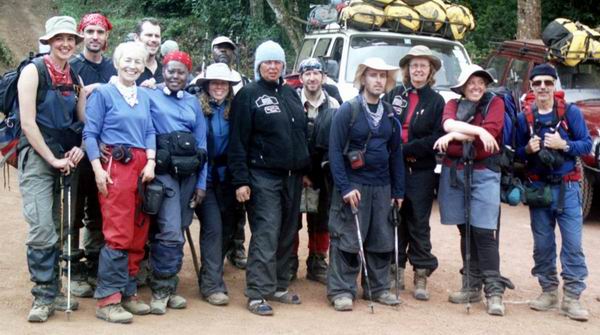
It was very quiet at breakfast on this last day. I guess we were all a bit sad that we were heading back down and out of the mountain – there is something about the spirit on the mountain! But, we were also happy to be going to the hotel for hot showers, cold drinks, and the much needed rest. The sun was out early, and by 8:00 am, we had eaten, packed and were heading down. I remember thinking – my knees hurt, but I am in good spirits! I was still coughing like an old drum….grrrrh…..I kept thinking – maybe I have water in my lungs – pulmonary edema! But Simon assured me that it is the dust and the thin air at the top of the mountain. I trusted him. He had been guiding people up and down that mountain for long enough to know if I was in any danger.
We reached Mweka camp (the last one on the route down) and continued the descent. Before long we were in the tree line and into the rain forest. Lush green trees, moss, purple and orange impatiens, fragrant magnolia trees, blue monkeys on the trees and birds calling out through the forest. Such a welcome sight and sound after days of climbing through bear land.
At dinner time, Simon presented us with our certificates. Green for those who reached Gillman’s point (Stella Point) and Gold for the rest of us who had pressed on to Uhuru Peak.
When climbing Kilimanjaro, one has time to observe and reflect. I had learned a great deal on Kili. I learned to observe the human spirit and what it was capable of. I learned that we can do anything we set our minds on. We can always do better!
 Our guides were ordinary Tanzanians, unassuming, poor even, not much in the way of education, no college degrees – yet their job was to guide us. Simon was a true leader. Responsible for the climbers, his fellow guides, and the large number of porters. We never went a single day without our meals, water, or snacks. He watched everyone and knew when we needed help and a little encouragement. All he, and the other guides wanted, was to see us succeed. That was what they set out to do each day and then made sure we succeeded. True leaders!
Our guides were ordinary Tanzanians, unassuming, poor even, not much in the way of education, no college degrees – yet their job was to guide us. Simon was a true leader. Responsible for the climbers, his fellow guides, and the large number of porters. We never went a single day without our meals, water, or snacks. He watched everyone and knew when we needed help and a little encouragement. All he, and the other guides wanted, was to see us succeed. That was what they set out to do each day and then made sure we succeeded. True leaders!
It took a whole year to get everyone into shape and to collect funds for the project and on September 22, 2004, we started the climb. Of the 13 team members – 5 of us got to the summit on 29th September. We help raised CAD $ 30,000 in cash and goods worth approximately CAD$ 125,000.
The climb was perhaps the most physically challenging task I have ever undertaken, but it was worth every step. While in Tanzania, we visited one of the children’s homes in Moshi town and gave presents of clothing to the children. Watching their smiles, made all the year’s training and climb, worth every step.

